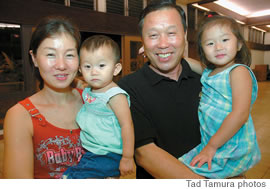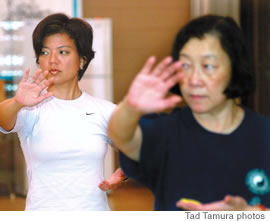Tai Chi’s Hawaii Roots
The son of the man who is believed to have brought tai chi to Hawaii continues to teach, and is planning a trip to China to celebrate the 108th birthday of the school in which his grandfather was an instrumental teacher

Grand master Zeng Chen Dong, wife Yan and the next
generation of grand masters, Malia and Kailey
Tai chi, like yoga, is supposed to make you sweat. I’ve tried both and neither has that effect on me.
But at the beginners’ tai chi class at the Jodo Mission of Hawaii on a not-so-distant Tuesday night, students wiped perspiration from their temples with shirt-sleeves in mid-motion, droplets hung from the tips of their noses, and students got energized, relaxed and an improved flow of internal energy, or chi.
“As you can see, it’s kind of rigorous,” student Joe Patti says with a laugh, motioning to his sweat-stained shirt.
Maria Lau of Waialae, who’s been practicing tai chi for more than three years for exercise, relaxation and improved mental and spiritual energy, says: “Tai chi seems very soft, but you use a lot of internal strength.
“You can feel the air moving with you and around you as you move. I’m sure it’s always doing that but with tai chi you can feel it.”
Twice a week in a Makiki Street facility, students wearing Dong Taijiquan Dao Academy T-shirts emblazoned with yin yang symbols and fighting stances gather for classes by grand master Zeng Chen Dong as fans spin overhead and cars speed by on the adjacent freeway.

Mark Hughes leads an advances class, including from
left, Joe Patti, Hamid Jahanmir, Ernesto Bonilla and
Marc Lebrun
Dong style classes are also taught at Heeia State Park, Kailua Recreation Center, Kapiolani Women’s Center, Spa Fitness Center in Honolulu, Straub Pearlridge and, for patients with arthritis, at the Chinese Cultural Plaza.
I joined the Makiki group for an inaugural lesson before the grand master was to lead his family and students from Hawaii and abroad (he has students as far afield as England) for a grand gathering in China, Hong Kong and Macao to celebrate what would be the 108th birthday of the school’s founder, Ying Jie Dong. Dong is well-known in martial arts circles for helping one of his teachers, Cheng Fu Yang, take tai chi to the masses.
In the 1970s Dong’s son Hu Ling was among the first, if not the first, to bring tai chi to Hawaii, and Dong’s grandson is Zeng, the current grand master standing at the head of the class, leading warm ups with terse, one-word instructions: “Waist. Knees. Reverse.” His son Alex is a former U.S. national Tai Chi Chuan champion in push hands from Hawaii and now teaches tai chi in New York.
As Zeng watches over the class in near silence, about 14 students perform the slow set, which is recognizable as the pattern of super slow-mo movements often seen done at public parks.

The author, left, and Maria Lau
As I’ve learned, slow doesn’t necessarily mean easy. Having grown accustomed over the years to the play-by-play instructions of aerobics classes and videos - as in: bend your knees, feet apart, feel the burn, imagine this so you feel that, etc. - learning tai chi by mimicking was tough for this beginner with no martial arts background. (Confession time: before this night I didn’t realize tai chi was a martial art. There’s even weaponry!)
One of my favorite sequences in the slow set involved a hanging hand motion, in which your fingers and thumb meet in such a way that I imagined it to be a delicate posture for holding a lantern. Turns out it’s a fighting tool used for striking. “If you keep your fingers apart, no energy; put them together and the energy comes here,” Dong says pointing to his wrist and striking it against his palm.
Some motions didn’t require explanation; the feeling came naturally. Passing the hands over the face in a downward motion, for example, instilled a sense of calm. Dong explained later that working hard during the day drives one’s energy and chi to the brain. When you pass the hands over the face, or up and down the body, it’s meant to suggest a circulation of blood and
Page 1 of 2 pages for this story 1 2 >
E-mail this story | Print this page | Comments (0) | Archive | RSS
Most Recent Comment(s):








